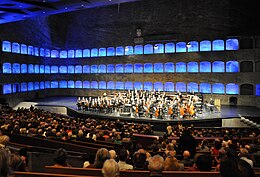Felsenreitschule
The Felsenreitschule is a venue for the Salzburg Festival .
The prince-archbishop's summer riding school
The Felsenreitschule was built in 1693 under Archbishop Johann Ernst von Thun according to plans by Johann Bernhard Fischer von Erlach on the site of the conglomerate quarry for the new Salzburg Cathedral , next to the court stables . It was used as an archbishop's summer riding school and for hunting animals. The audience found space in the 96 arcades , which are laid out over three floors.
In 1841 the riding school was adapted, expanded and covered as a kk cavalry riding arena for the Hofstall barracks. After the First World War, the first federal army was also stationed here.
Festival venue
Since 1926 the Felsenreitschule has been used for open-air performances of plays as part of the Salzburg Festival . The former spectator arcades have served as a natural stage set since then . The first production was Carlo Goldoni's The Servant of Two Masters , directed by Max Reinhardt .
1933 built Clemens Holzmeister for Max Reinhardt here Fauststadt , a multiple stage for Reinhardt's legendary production of Goethe's Faust .
Herbert von Karajan transformed the Felsenreitschule into an opera stage for the first time in 1948 for performances of Christoph Willibald Gluck's Orfeo ed Euridice . In 1949, Carl Orff's setting of the ancient tragedy Antigonae by Sophocles in the German translation by Friedrich Hölderlin, under the baton of Ferenc Fricsay, followed .
In the years 1968–1970 the Felsenreitschule was redesigned according to plans by Clemens Holzmeister and inaugurated with Ludwig van Beethoven's Fidelio under the direction of Karl Böhm . The 40 meter wide stage was given a lower stage 4 meters deep. The cantilevered spectator stand with the backdrop depot underneath was also renewed. A lightproof, extendable rain tarpaulin with a rain net to dampen the noise protects the stage. This roof can be opened.
The mobile roof was renewed between the festival summers of 2010 and 2011: Thanks to the modern construction, the festival gained 700 m² of usable space for technology and rehearsal rooms. The new monopitch roof consists of three mobile segment surfaces and can be retracted and extended on five telescopic arms within six minutes. Suspension points on telescopic supports for stage technology (chain hoists), improved noise and heat insulation and two lighting bridges optimize the action on the stage. The building was designed by the HALLE 1 team of architects and was awarded the Salzburg State Architecture Prize in 2012 .
The Felsenreitschule has 1412 seats and 25 standing places. It shares its foyer with that of the Haus für Mozart (Kleines Festspielhaus) .
See also
literature
- Norbert Hierl-Deronco: Theatrum Equorum Salisburgensium. Steeds, riders, buildings from the Baroque and Colloredo times. Krailling 2007, ISBN 978-3-929884-11-1 .
Web links
Individual evidence
- ↑ Erhard Koppensteiner: The Christian Doppler Gymnasium, built as a kuk infantry battalion barracks in Salzburg-Lehen. Contributions to its building, art and military history. In: Landesgeschichte aktuell No. 137, December 2006, 1. On the barracks in Salzburg , p. 20 , column 2 (full article, pp. 20–26; article, pdf, rainerregiment.at ; whole booklet, pdf, salzburger-geschichte. at , there each p. 1)
-
↑ New mobile roof over the Felsenreitschule ( memento of the original from May 21, 2012 in the Internet Archive ) Info: The archive link was inserted automatically and has not yet been checked. Please check the original and archive link according to the instructions and then remove this notice. , halle1.at;
Mobile roof Felsenreitschule , entry in nextroom.at
Coordinates: 47 ° 47 ′ 54 ″ N , 13 ° 2 ′ 30 ″ E





